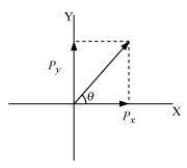Consider a vector 𝑃⃗⃗, given as:
On comparing the components on both sides, we get:
Hence, the magnitude of the vector is .
Let 𝜃 be the angle made by the vector 𝑃⃗⃗, with the x-axis, as shown in the following figure.
Hence, the vector makes an angle of 45° with the x-axis.
Hence, the magnitude of the vector is √2.
Let 𝜃 be the angle made by the vector , with the x-axis, as shown in the following figure.
Hence, the vector makes an angle of -45° with the x-axis.
It is given that:
On comparing the coefficients of and , we have:
Let make an angle 𝜃 with the x-axis, as shown in the following figure.
The angle between the vectors
Component of vector , along the direction of , making and angle 𝜃.
Let be the angle between the vectors
Component of vector 𝐴⃗, along the direction of 𝑄⃗⃗, making and angle 𝜃.



